Polski Senovets
| Polski Senovets Полски Сеновец | |
|---|---|
| Village | |
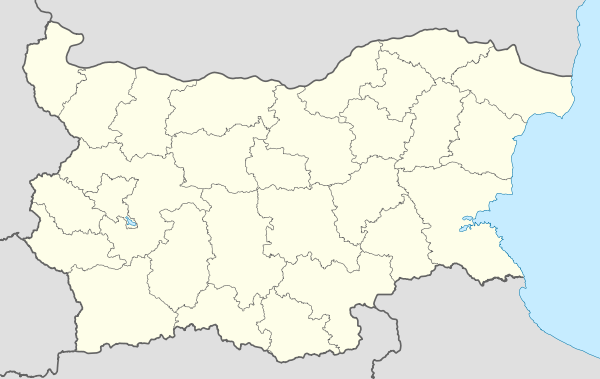 Polski Senovets | |
| Coordinates: 43°09′25″N 25°18′00″E / 43.15694°N 25.30000°ECoordinates: 43°09′25″N 25°18′00″E / 43.15694°N 25.30000°E | |
| Country | Bulgaria |
| Province | Veliko Tarnovo |
| Community | Polski Trambesh |
| Government | |
| • Mayor | Maryan Tonev |
| Area | |
| • Total | 37,508 km2 (14,482 sq mi) |
| Elevation | 134 m (440 ft) |
| Population | |
| • Total | 770 |
| Time zone | EET (UTC+2) |
| • Summer (DST) | EEST (UTC+3) |
| Post code | 5193 |
| Area code(s) | 06146 |
Polski Senovets (Bulgarian: Полски Сеновец) is a village in Veliko Tarnovo Province, north-central Bulgaria.
Geography
Location
Polski Senovets is located in the central part of the Danubian Plain. The village is 12 km (7.5 mi) away from Polski Trambesh, 37 km (23 mi) from Veliko Tarnovo, 4.4 km (2.7 mi) from the village of Stefan Stmabolovo, 4.4 km (2.7 mi) from the village of Petko Karavelovo and 3 km (1.9 mi) away from village of Ivancha.
Other nearby places include Bratanevets, west of the village, Beloopastritza to the north, and Oreshaka, the most fertile area, also to the north.
Polski Senovets has several neighborhoods. Tabak was the first neighborhood, Gorna is the biggest, with the largest Karaivanovi in the village, and Dolna was established after the deportation of the Ottoman Turks.
Hydrography
There is a dam near the village.
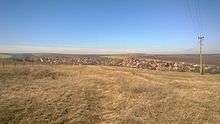
Soils
The soils in the area are typical of the Danubian Plain, approximately 80% black soil and 20% forest soil.
Climate
The climate in Polski Senovets is continental. The temperatures range from 28 °C (82 °F) in August to −4.5 °C (23.9 °F) in January.[1]
Flora and fauna
Trees in the area are mostly deciduous, with a smaller number of conifers. Lime, winter oak, hornbeam, and poplar are typical. Wildlife is that of the Danubian Plain, with rabbits, foxes, mice, hamsters and deer seen year-round.
History

The first known inhabitation in Polski Senovets was about 2000 years ago. Originally a Roman village, it was home to horse and sheep breeders. Archives say that Polski Senovets were called Senovyats or Osyanovets. There were several small villages nearby, Sarnitsa, Glogota, and Dunavliy Suvandzhikyoy, with 100–200 people each. When the Ottomans attacked, the villagers united in what is now Polski Senovets. During Ottoman rule, most people worked as farmers or craftsmen (especially potters). The name Senovets (Bulgarian:Сеновец) comes from the lush vegetation grown in the land of today's village. In the 1300s, Polski Senovets' population were mostly farmers and potters, though some worked in the capital Veliko Tarnovo as warriors and advisors (on the safety of the Capital's region). People from the Polski Senovetz were proud of the stories about Nicopolis ad Istrum, who came from nearby.
The first mayor, chosen in 1887, was Tasho Delimapinov. Georgi Plakovski was the first tailor in the village. At that time tailoring was one of the most important and popular crafts in the region.
The village experienced three large earthquakes (with a magnitude greater than seven on the Richter scale) between 1908 and 1913.[2]
From 1902 to 1926, Polski Senovets was home to a Regional bank and part of the Bulgarian farm bank. In 1911, the first post office opened, connecting the town by telephone and telegraph service as well as by mail.
Saglasie Consumer Cooperative was founded in 1919; in 1922, 87 residents were members. A monument of Georgi Dimitrov was built in the center of the village, in 1971. The year after, the settlement chose the first woman mayor, Maria Vlahova, from the Bulgarian Socialist Party. The current mayor as of 2011 is Maryan Tonev.
Population
| Year | 1882 | 1893 | 1900 | 1920 | 1934 | 1946 | 1956 | 1965 | 1975 | 1984 | 1991 | 2001 | 2012 |
|---|---|---|---|---|---|---|---|---|---|---|---|---|---|
| Population | 2101 | 2274 | 2378 | 2817 | 3012 | 2990 | 2922 | 2730 | 2231 | 2270 | 1602 | 870 | 580 |
Members from the old families in Polski Senovets have moved to nearby villages and the towns of Polski Trambesh, Gorna Oryahovitsa, Veliko Tarnovo, Varna and others. These families include, Karaivanovi, Tonkovi, Mihtievi, Chonovi, Dachevi, Azgorovi, Prashanovi, Bodurkovi, Manafovi, Zarzalanovi, Chetalbashevi, Popovi, Yabadjievi, Ulaibevi, and Shishmanovi.
Religion
Over 90% of the people in Polski Senovets are Orthodox Christians. The Orthodox Church, St. Theodore Stratelates, was built in 1836–1837 with resources from residents of the village. The first Priest of the church was Petar Marinov Danchev (1793–1897).
Education
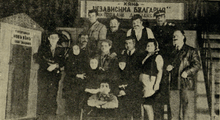
Primary School, Nikola Yonkov Vaptsarov
The first school in Polski Senovets was founded in 1847 with teachers who were priests from the Orthodox church in the village. In 1880, a bigger building was built with four classrooms. In the following years, Polski Senovets's school began to educate teachers from Veliko Tarnovo and Gorna Oryahovitsa. The first known teacher is Sava Myhaylovski from Veliko Tarnovo. He start to teach in the school since 1854. He knew Bulgarian, Greek and Turkish.
In 1900,the school year starts with around 100 students. The school were separated to two parts:Primary school and ProGymnasium. The following year the school burned down. A new building were constructed in 1905.Children from Polski Senovets, Petko Karavelovo and Stefan Stambolovo were educated there. The first personРwho were called director of the school were Kiro Gaytanzhiev. He was director and teacher since 1909 to 1919.
In 1977, the school celebrated its 120th anniversary. That same year, the second story was destroyed by a powerful earthquake; restoration was completed in 1980. The school received the Cyril and Methodius medal from the Bulgarian government. The school festival is held on 7 December. From the beginning of 70s in the school were created outside classes in the disciplines:Rocket modelling,Tractor activities,Electro-constructing and Flowering.

Library Nadejda, 1883
The earliest library documents date from 1883; thus this is accepted as the date of its founding.

Library organizations
- Folklore group, Nezabravka
- Women's folklore group, Polska kitka
- Men's group for Renaissance and patriotic songs, Rodolubie
- Group for retro songs, Zlaten klas
- Comedy group
- Theater group
- Group for arts and speech
Economy
Farm cooperatives
Labor-Cooperative Farm Valko Chervenkov (LCF Valko Chervenkov) (Bulgarian:Трудово кооперативно земеделско стопанство"Вълко Червенков") was founded in 1949 in Polski Senovets with 55 members. The first car owned by the cooperative was a GAZ Pobeda purchased in 1952. In 1956, LCF Valko Chervenkov was renamed to LCF Hristo Botev. For a few years cotton was grown in the Polski Senovets area. In 1958, Labor-Cooperative Farm Georgi Dimitrov was merged with the labor-cooperative farms of nearby villages, Petko Karavelovo, Kutsina and Gradina. The center of the farm was in Polski Senovets. The first tractors in the village were the Bulgarian machines Bolgar TL-30 and Bolgar TL-60. The farm also had 3 Chavdar-5C buses. In the 1970s, a project was created to install an irrigation system, which was accomplished with money from Labor-Cooperative Farm Georgi Dimitrov. The company was privatized in 1989. Farm Cooperative Golden field was founded in 1989, after privatization of United Labor-Cooperative Farm Georgi Dimitrov.
Agriculture
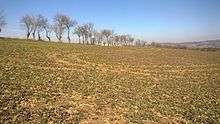
The total arable land is 28,878 hectares (71,360 acres).
- Cereals: wheat (34%), barley (14%), corn (12%), sunflower (9%), oat (6%), soybean (5%), sugar beet (4%)
- Perennial plantations with the highest percentage: vineyards (19%), apples (11%), cherries (9%), wicker.
- Vegetable production: tomato (22%), potato (15%), cabbage (8%).
Livestock
In 1958, records listed the following numbers for the village livestock: cattle, 452; pigs, 343; horses, 271; sheep; 2295.
Industry
Podem Ltd.
Pedom Ltd. is based in the town of Polski Trambesh, but has factories in the villages of Polski Senovets and Pavel. In 2010, the factory in Polski Senovets employed 20 workers. The plant specializes in the production of mechanical and electrical parts for home appliances.
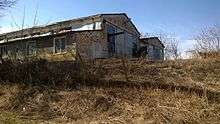
Transport
Automobile transport
The main road, E85, runs near Polski Senovets and connects the towns Rousse, Veliko Tarnovo and Stara Zagora.
Rail transport
In 1900, a railway was built between Rousse and Stara Zagora; it is 3 km (1.9 mi) from Polski Senovets.
Festivals
The village festival is held annually on 10 June.
Sport
- FC Spartak Polski Senovets was established in the 1950s. The club played football (soccer) in Veliko Tarnovo`s Regional league.
Sources
- Regional state archive – Veliko Tarnovo
- Polski Senovets – by Todor Lazarov(Полски Сеновец – Тодор Лазаров 1984 издателство "Отечествен фронт"(Bulgarian)) created with the help of Georgi Mihaylov, Bogdan Sultov Angel Subev, Kiril Popov.
- Page Folk "Nadezhda 1883"
- Map of Polski Trambesh
- Article on "Nadejda"
References
- ↑ "Climate: Polski Senovets - Climate graph, Temperature graph, Climate table - Climate-Data.org". en.climate-data.org. Retrieved 2015-04-11.
- ↑ "Worldwide earthquakes updated in real time since 1904". Earthquakes 24. Retrieved 2015-04-11.